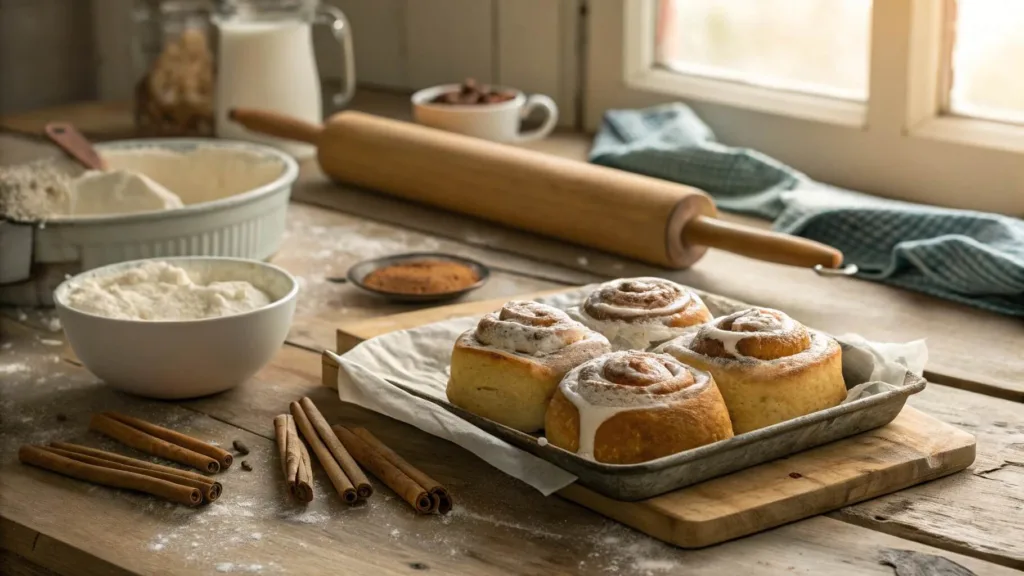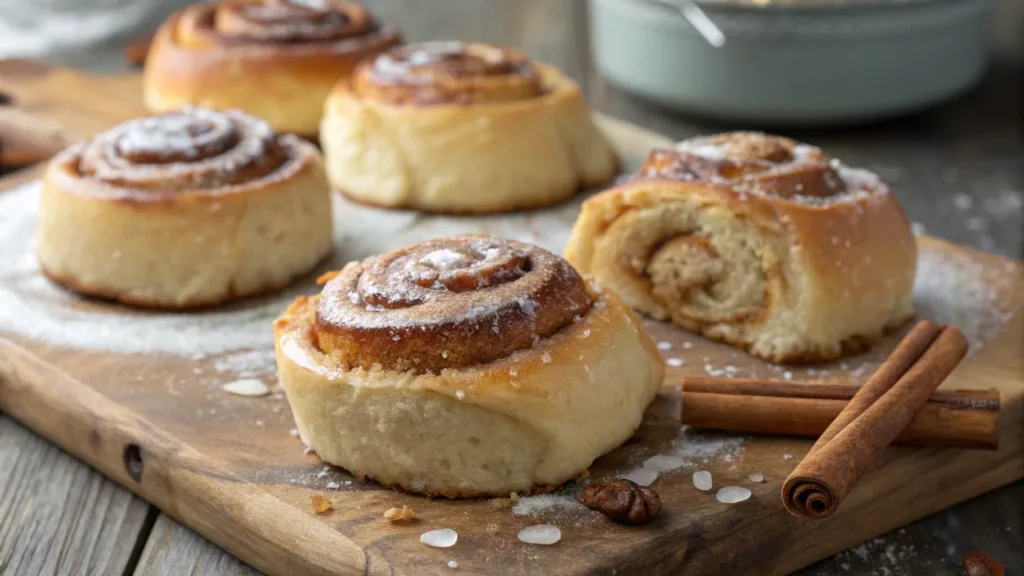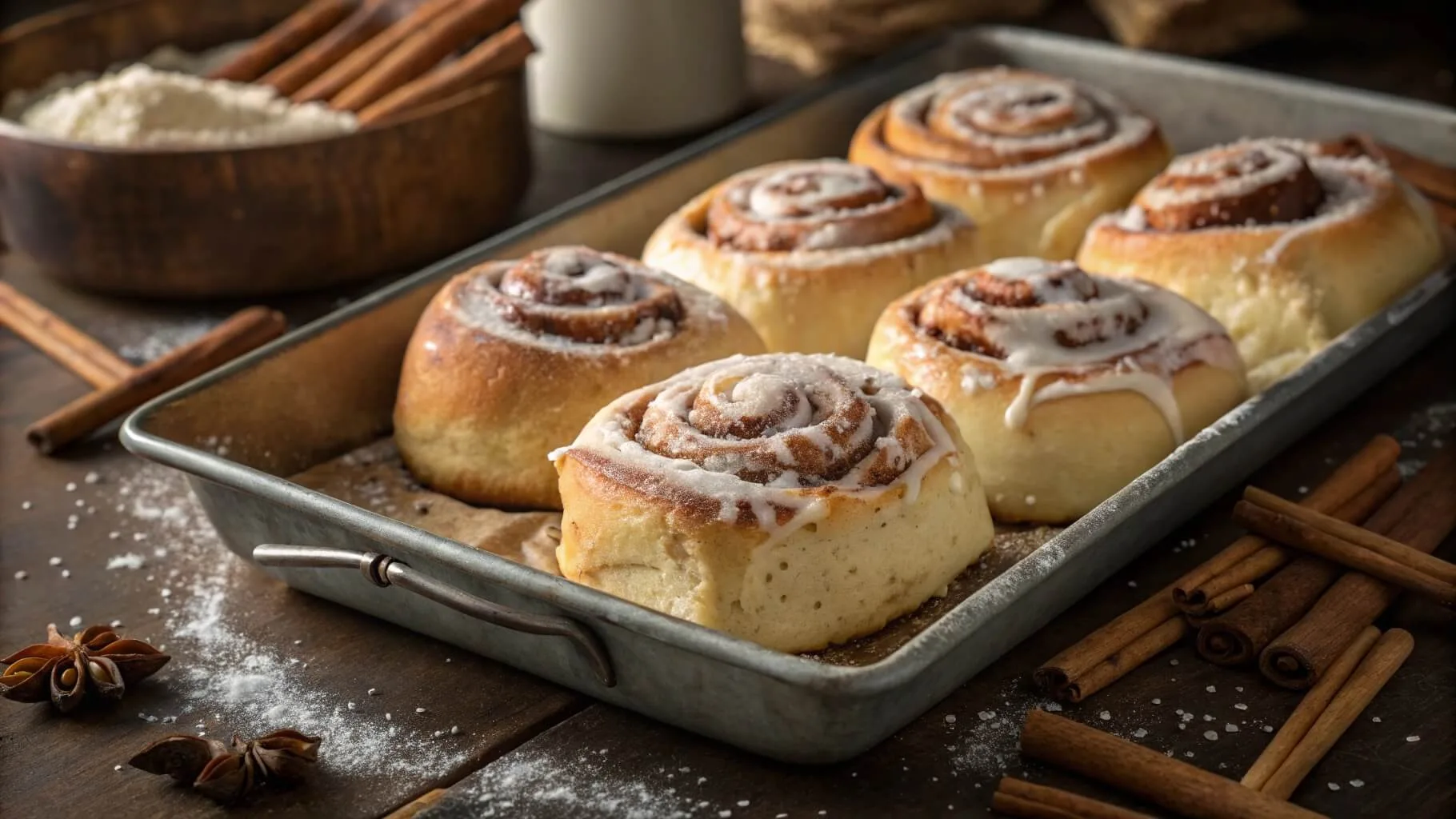Imagine waking up to the sweet aroma of freshly baked sourdough cinnamon rolls. They are soft and fluffy inside, and golden brown outside. This recipe is your guide to making these delicious pastries at home. It focuses on the sourdough cinnamon rolls recipe, showing you how to make them step by step.
This guide covers everything from sourdough basics to mastering the dough. Making sourdough cinnamon rolls at home is easy with the right ingredients and tools. Whether you’re new to baking or have some experience, this guide will help you make soft and fluffy sourdough cinnamon rolls. They’re perfect for any special occasion.
Main Points For Sourdough Cinnamon Rolls Recipe
- Learn the basics of sourdough and its importance in the sourdough cinnamon rolls recipe
- Understand the equipment and ingredients needed for the sourdough cinnamon rolls recipe
- Master the step-by-step process of creating the perfect dough for sourdough cinnamon rolls
- Discover the secrets to making soft and fluffy sourdough cinnamon rolls
- Get tips on how to store and reheat your sourdough cinnamon rolls for maximum freshness
- Explore variations of the sourdough cinnamon rolls recipe to suit your taste preferences
Understanding the Magic of Sourdough Cinnamon Rolls Recipe
To make delicious homemade sourdough cinnamon rolls, you need to know the process. They use a natural starter culture, not commercial yeast. This gives them a unique flavor and texture. The dough ferments, which takes time, but it’s worth it.
When making these rolls, patience is key. Let the natural starter culture do its work. The fermentation process is what makes sourdough special. It’s what gives these rolls their unique taste and texture.
What Makes Sourdough Cinnamon Rolls Recipe Special
Several things make sourdough rolls special. They use a natural starter culture and ferment. This results in a delicious and unique flavor and texture.
- A more complex flavor profile
- Better digestion due to the fermentation process
- A unique and delicious texture
The Science Behind Sourdough Fermentation
Sourdough fermentation is a natural process. It involves letting the dough ferment, which takes time. This is what makes sourdough different from other breads.

Benefits of Using Sourdough Starter
Using a sourdough starter has many benefits. It adds a more complex flavor and improves digestion. The fermentation process also makes the rolls easier to digest.
By using a sourdough starter and letting the dough ferment, you can make delicious homemade sourdough cinnamon rolls. They are perfect for any occasion.
Essential Equipment for Perfect Sourdough Cinnamon Rolls Recipe
To make perfect sourdough cinnamon rolls, you need the right tools. A stand mixer mixes the dough well. A dough scraper helps with sticky dough. A baking sheet is for baking, and a proofing basket is for fermentation.
Having the right tools makes the process easier. It ensures your rolls are soft and fluffy.
Some key equipment for soft and fluffy cinnamon rolls includes:
- Stand mixer: for mixing the dough
- Dough scraper: for handling the sticky dough
- Baking sheet: for baking the rolls
- Proofing basket: for the fermentation process
Using the right equipment helps get the perfect texture and flavor. Quality equipment makes a big difference in your baking.

Ingredients for Your Sourdough Cinnamon Rolls Recipe
To make the best sourdough cinnamon rolls, you need top-notch ingredients. The recipe calls for flour, water, salt, sugar, and yeast (in the form of a sourdough starter) for the dough. For the filling, you’ll need cinnamon, sugar, and butter. You can choose between a cream cheese frosting or a simple glaze for the frosting.
Dough Components
The dough is key to making delicious sourdough cinnamon rolls. You’ll need:
- Flour: provides structure and texture
- Water: hydrates the dough
- Salt: enhances flavor
- Sugar: feeds the sourdough starter
- Sourdough starter: causes fermentation
Filling Ingredients
The filling adds sweetness and spice to your rolls. You’ll need:
- Cinnamon: adds warmth and flavor
- Sugar: balances the spice
- Butter: adds richness and moisture
Frosting Options
For the best taste, consider a cream cheese frosting or a simple glaze. These frostings will enhance your sourdough cinnamon rolls recipe, making them even more tasty.
Preparing Your Active Sourdough Starter
To make delicious homemade sourdough cinnamon rolls, you need an active sourdough starter. This means feeding it regularly and letting it ferment. A healthy starter will make your rolls rise and taste great.
Here are some key points to consider when preparing your sourdough starter:
- Feed your starter regularly: This keeps it active and healthy.
- Allow the starter to ferment: This step enhances the flavor and texture of your rolls.
- Monitor the starter’s consistency: A good starter is bubbly, frothy, and has a sour smell.
By following these steps, you’ll create a thriving sourdough starter. This will take your homemade sourdough cinnamon rolls to the next level.
Remember, patience is key when working with sourdough starters. With regular care and attention, you’ll get delicious homemade sourdough cinnamon rolls. They’re sure to impress.
Creating a sourdough starter from scratch can be a fun and rewarding experience. With the right techniques, you can achieve professional-grade results at home.
Making the Perfect Dough
To make soft and fluffy cinnamon rolls, you need to create a dough that’s both tender and strong. This starts with mixing and kneading. These steps help develop the dough’s gluten, which gives the rolls their shape and texture.
It’s important to find the right balance between mixing too much and too little. A well-mixed dough should be smooth, elastic, and slightly shiny. Understanding the role of each ingredient and their amounts is key to achieving this.
Mixing Techniques
Mixing is the first step in making dough. It combines ingredients into a single mass. This stage is crucial for the dough’s development in the next steps.
- Temperature: Make sure all ingredients are at room temperature for even mixing.
- Sequence: Add ingredients in a specific order to avoid overmixing and ensure complete incorporation.
- Time: Mix the dough for the right amount of time to develop gluten without overworking it.
Kneading Methods
Kneading makes the dough stronger and more elastic. You can knead by hand or use a stand mixer with a dough hook. The goal is to stretch and fold the dough gently, repeating this several times.
First Fermentation Tips
After mixing and kneading, the dough starts its first fermentation. This is where yeast breaks down sugars and produces carbon dioxide. It’s essential for the rolls’ flavor and texture. To help, keep the temperature steady, use a lightly oiled bowl, and cover it to prevent drying.
Creating the Cinnamon Filling
To make the best sourdough cinnamon rolls, the cinnamon filling is key. It gives them their unique flavor and smell. The right mix of cinnamon, sugar, and butter is crucial for a tasty filling.
Making the cinnamon filling involves mixing cinnamon, sugar, and butter. Using top-notch ingredients is important for the best taste. For authentic flavor, choose fresh cinnamon and real butter.
- Cinnamon: Fresh and of high quality for the best flavor.
- Sugar: Balances the spice of the cinnamon.
- Butter: Adds richness and moisture to the filling.
By following these steps and using the right ingredients, you can make a cinnamon filling that will take your sourdough cinnamon rolls to the next level. They will be the best sourdough cinnamon rolls you’ve ever tasted.
Rolling and Shaping Techniques
To make perfect sourdough cinnamon rolls, you need to get good at rolling and shaping. This means rolling the dough to the right thickness, spreading the cinnamon filling evenly, and cutting the rolls into perfect portions. A good sourdough cinnamon rolls recipe will help you through this, making your rolls soft, fluffy, and full of flavor.
When rolling out the dough, keeping it the same thickness is key for even baking. Roll it out to about 1/4 inch thick. This ensures the dough and cinnamon filling balance out perfectly. For authentic rolls, use a mix of all-purpose flour, sourdough starter, and a bit of sugar for a tender crumb.
Step-by-Step Rolling Guide For Perfect Sourdough Cinnamon Rolls Recipe
- Roll out the dough on a lightly floured surface to the desired thickness.
- Spread the cinnamon filling evenly, leaving a 1-inch border around the edges.
- Roll the dough into a tight log, starting from the long side.
- Cut the log into 12-15 equal pieces, depending on the desired size of your rolls.
By following these steps and using a reliable sourdough cinnamon rolls recipe, you’ll make delicious, mouthwatering rolls. Arrange the rolls in the pan so they bake evenly, leaving about 1 inch of space between each roll.
Second Rise and Proofing
After shaping the homemade sourdough cinnamon rolls, they need a second rise and proofing. This step is key for their final shape and size. The right environment ensures they rise evenly and are ready for baking.
To get the rolls just right, place them in a warm, draft-free spot. Keep them away from direct sunlight. The best temperature for proofing is between 75°F and 80°F. This helps with even fermentation.
Some important things to think about during the second rise and proofing include:
- Humidity: Keep the environment humid to prevent the rolls from drying out.
- Time: Let the rolls proof for 1-2 hours, or until they double in size.
- Monitoring: Check the rolls often to make sure they’re proofing evenly and not over-proofing.
By following these tips, you’ll get perfectly proofed homemade sourdough cinnamon rolls, ready for baking. Keep an eye on the rolls during proofing. Over-proofing can make them less tasty.
Baking Your Sourdough Cinnamon Rolls
To make soft and fluffy cinnamon rolls, focus on the baking. It’s important to watch the temperature and timing. This ensures the rolls bake evenly and get a golden-brown color.
When baking soft and fluffy cinnamon rolls, consider these key factors:
- Temperature: Preheat the oven to the correct temperature (usually around 375°F) to ensure the rolls bake evenly.
- Timing: Keep an eye on the timer, as overbaking can lead to dry rolls. The baking time will depend on the size of the rolls and the oven temperature.
Look for visual cues to know when the rolls are done. Check for a golden-brown color and a soft, fluffy texture. After baking, cool the rolls properly. This keeps them soft and fluffy.
By following these guidelines and paying attention to the baking process, you’ll create delicious, soft and fluffy cinnamon rolls. They’re perfect for any occasion.
Frosting Options and Toppings
To make the best sourdough cinnamon rolls, think about the frosting and toppings. A classic cream cheese frosting is a favorite, but you can also try other glazes and toppings.
The right frosting can make a big difference. For a classic cream cheese frosting, mix softened cream cheese with butter, vanilla, and powdered sugar. This frosting goes well with the sweet and spicy flavors of the rolls.
Classic Cream Cheese Frosting
To make the frosting, beat the cream cheese and butter until smooth. Then, add vanilla extract and powdered sugar. You can adjust the consistency and flavor to your liking.
Alternative Glazes
For a lighter topping, try a glaze made from powdered sugar and milk. You can flavor it with vanilla or other extracts. Other options include a caramel glaze or a fruit-based topping, like strawberry or raspberry glaze.
The choice of frosting or topping is up to you. Try different options to find the perfect match for the best sourdough cinnamon rolls.
Storage and Reheating Tips
To keep your sourdough cinnamon rolls fresh, proper storage is key. After baking and frosting, store them in an airtight container at room temperature for up to 3 days. For longer storage, freeze the rolls. Place them in a single layer in a freezer-safe bag or container to prevent sticking.
Reheating your sourdough cinnamon rolls is important to keep their texture and flavor. Here are some tips:
- Reheat the rolls in the microwave: Wrap a roll in a damp paper towel and heat for 20-30 seconds.
- Reheat the rolls in the oven: Place the rolls on a baking sheet and heat at 350°F (175°C) for 5-7 minutes.
By following these storage and reheating tips, you can keep your homemade sourdough cinnamon rolls fresh and delicious. These tips are great whether you’re making a sourdough cinnamon rolls recipe from scratch or adapting one to your taste.
FAQs For Sourdough Cinnamon Rolls Recipe
Here are answers to some of the most frequently asked questions about sourdough cinnamon rolls, covering differences from regular cinnamon rolls, troubleshooting tips, and ingredient insights.
1. What’s the difference between sourdough cinnamon rolls and regular cinnamon rolls?
Sourdough cinnamon rolls are naturally leavened with a sourdough starter, while regular cinnamon rolls use commercial yeast. This difference affects both flavor and texture:
| Feature | Sourdough Cinnamon Rolls | Regular Cinnamon Rolls |
|---|---|---|
| Leavening Agent | Wild yeast & bacteria (sourdough starter) | Commercial yeast (instant or active dry) |
| Flavor | Slight tanginess with depth | Mild, sweet flavor |
| Fermentation Time | 8-12 hours (long fermentation) | 1-2 hours (quick rise) |
| Texture | Soft, fluffy, and slightly chewy | Light and airy |
| Health Benefits | Easier to digest, lower glycemic impact | Standard yeast-based benefits |
The slow fermentation process in sourdough develops more complex flavors and makes the rolls easier to digest, while regular cinnamon rolls are faster to prepare but lack the distinct depth of sourdough.
2. Why are my sourdough cinnamon rolls not fluffy?
If your cinnamon rolls turn out dense instead of soft and airy, it’s usually due to one of the following reasons:
✔ Underproofed dough – If the dough hasn’t doubled in size before baking, it needs more time to ferment. Let it proof in a warm spot until it’s puffy.
✔ Too much flour – Adding too much flour during kneading can make the dough stiff and dry, preventing a soft texture. The dough should be slightly sticky but manageable.
✔ Overproofed dough – If left too long, the dough can weaken, causing the rolls to collapse in the oven. The dough should be light and airy, not deflated.
✔ Cold environment – Sourdough rises best in a warm, draft-free area (75-80°F / 24-27°C). If your kitchen is too cold, proof the dough in an oven with the light on.
✔ Weak sourdough starter – If your starter isn’t active and bubbly, the dough won’t rise properly. Make sure your starter passes the float test before using it in the recipe.
3. What is the secret ingredient in Cinnabon cinnamon rolls?
The secret to Cinnabon’s iconic flavor is their special type of cinnamon called Makara cinnamon. This variety has a stronger, sweeter, and more aromatic profile than regular cinnamon, giving the rolls their signature warm and rich flavor.
Additionally, Cinnabon uses:
- Brown sugar for deep caramelization
- Plenty of butter in the filling for extra richness
- A generous amount of cream cheese frosting to enhance moisture and sweetness
If you want to replicate that signature Cinnabon taste, try using high-quality Saigon or Ceylon cinnamon in your filling and extra butter for a gooey center.
4. What’s the point of using sourdough discard?
Sourdough discard is the portion of starter you remove before feeding, and instead of wasting it, you can use it in recipes like sourdough discard cinnamon rolls.
Why use sourdough discard?
✔ Adds a mild sourdough flavor without long fermentation
✔ Reduces food waste by repurposing leftover starter
✔ Improves texture – slightly chewy but still fluffy
✔ Can be used immediately – no need for extended proofing
Difference Between Active Starter vs. Discard:
| Feature | Active Starter | Sourdough Discard |
|---|---|---|
| Leavening Power | Strong (helps dough rise) | Weak (needs additional yeast or baking powder) |
| Flavor Impact | Tangy, full sourdough taste | Milder sourdough tang |
| Best Used For | Long-fermented doughs | Quick sourdough recipes |
If you’re short on time, using sourdough discard + a pinch of baking powder allows you to enjoy cinnamon rolls without waiting for extended fermentation.
Conclusion
Making the perfect sourdough cinnamon rolls takes patience and detail. This guide will help you make soft, fluffy cinnamon rolls that everyone will love.
Success comes from a good sourdough starter, careful mixing, and precise shaping. With practice, you’ll make sourdough cinnamon rolls that rival the bakery’s.
Don’t be shy to try new fillings and frostings. Let your creativity flow. Enjoy baking these delectable cinnamon rolls and relish the fruits of your labor. Happy baking!

